Loan-related data entry survey – preliminary results (13 August 2022)
This page summarises the preliminary results of Documentation Standards Working Group’s survey of the time taken by museum staff to transfer object data between systems by hand when borrowing and lending objects. It covers returns received until 15:30 CET on 13 August 2022.
It’s clear that our sample is still small and unrepresentative, so we would encourage anyone who has not already completed the survey to do so, and to circulate it as widely as possible amongst their contacts and networks. It can be found here. We plan to report revised findings in a webinar organised by Collections Trust on 13 October, and again at the European Registrars Conference in November.
The sample
We had 42 usable results (although not everyone filled in all the questions).
7. In what country is your museum?
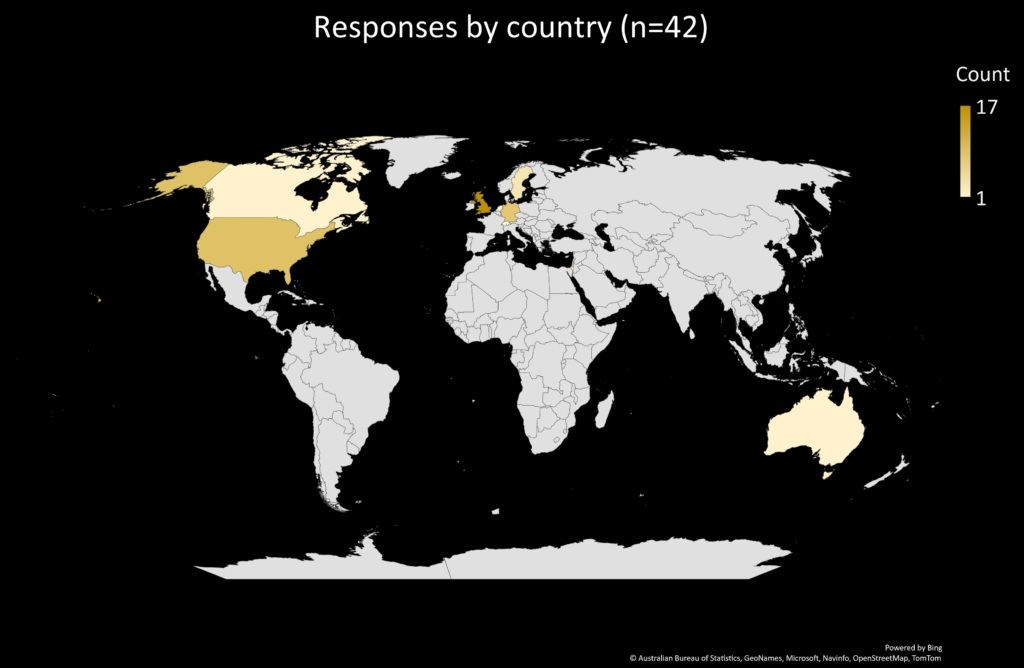
Because of the channels used to circulate the survey, there’s a strong geographical bias to the sample:
| 1 | |
| Canada | 1 |
| Germany | 8 |
| Israel | 1 |
| Netherlands | 1 |
| Sweden | 3 |
| Switzerland | 1 |
| United Kingdom | 17 |
| United States | 9 |
- 40% of responses came from the UK
- Around 20% each came from Germany and the United States
- The remainder were distributed between a further 6 countries
6. What is your museum’s annual operating budget?
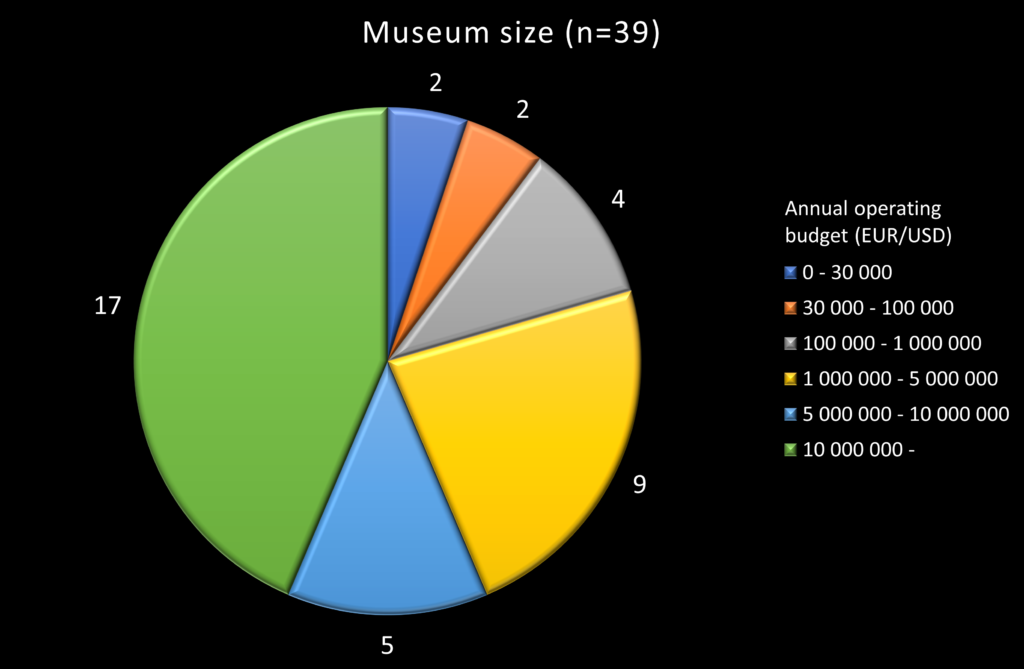
As we might expect, nearly half our responses came from the largest museums – indicated by an annual operating budget of more than 10 million Euros or US dollars; and nearly 80% of responses came from museums with budgets greater than 1 million Euros or dollars.
5. Which collections management system do you use?
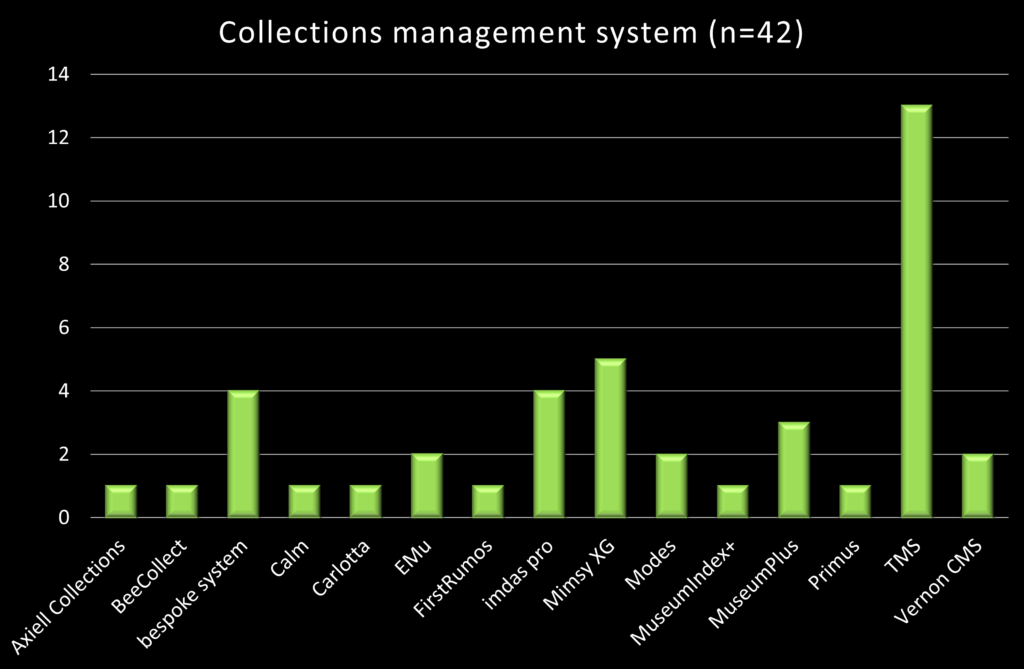
Again, due to the channels initially available to us, there’s a strong bias towards users of the TMS collections management system in the sample: they make up 30%. Next are Mimsy XG users, followed closely by users of imdas pro and (perhaps worryingly?) bespoke systems. It’s worth noting that if we lump all Axiell users together they account for 17% of responses.
Data tidying and presentation
Responses necessarily varied in quality. Although asked to provide single figures, respondents often produced ranges; for the purposes of this report, the average figure has been used. Figures reported as ‘less than’ or ‘greater than’ have simply used the number reported, as there was no obvious way of discovering the other boundary.
One museum reported that they spent 5,760 minutes to enter the data for a single loan in; based on their other responses, this has been taken as a data-entry error for 57-60 minutes which, although high, is not atypical.
In order to visualise data in a relatively useful form, individual figures have been assigned to bands, arranged in a roughly (but not strictly) logarithmic scale; these have been plotted against the number of museums reporting a figure within the relevant band. Figures for loans out (generally less time-consuming) are in green; those for loans in are in red.
The orthography of free-text responses has been tidied up; any expansions or interpolations are included in square brackets.
Number of loans out and in, in a year
1. Roughly how many objects do you lend in a year (i.e. loans out)?
3. Roughly how many objects do you borrow in a year (i.e. loans in)?
Respondents were asked to include short and long-term loans. For all loans, if a loan is for more than a year, it should only be counted when the initial loan is made, or it has to be renewed and new agreements etc. are issued.
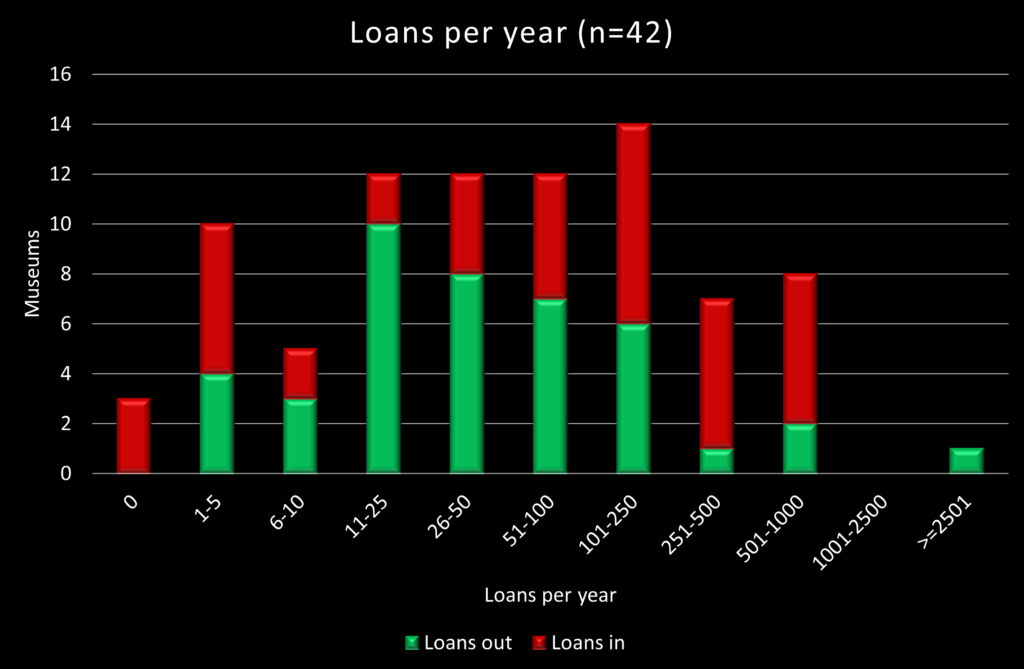
| Loans out | |
| minimum | 2 |
| median | 31.5 |
| mean | 166 |
| maximum | 3000 |
| Loans in | |
| minimum | 0 |
| median | 92.5 |
| mean | 194 |
| maximum | 750 |
There is a clear bias towards museums lending more objects than they borrow. Generally, for both loans out and in, the majority of museums lend or borrow fewer objects, whilst a few museums lend or borrow significantly more – so the medians for both types of loan are significantly less than the means: a medium of 31.5 objects lent and 92.5 borrowed, compared to a mean of 166 lent and 194 borrowed. But do bear in mind the maximums: 3,000 objects lent and 750 borrowed.
Time taken to enter data
2. Roughly how many minutes does it take you to transfer a single object’s identification and requirement data from your collections management system into loan agreements and other paperwork to send to the lender, for loans out?
4. Roughly how many minutes does it take you to transfer the lender’s object identification and requirement data into your collections management system, for a single object, for loans in?
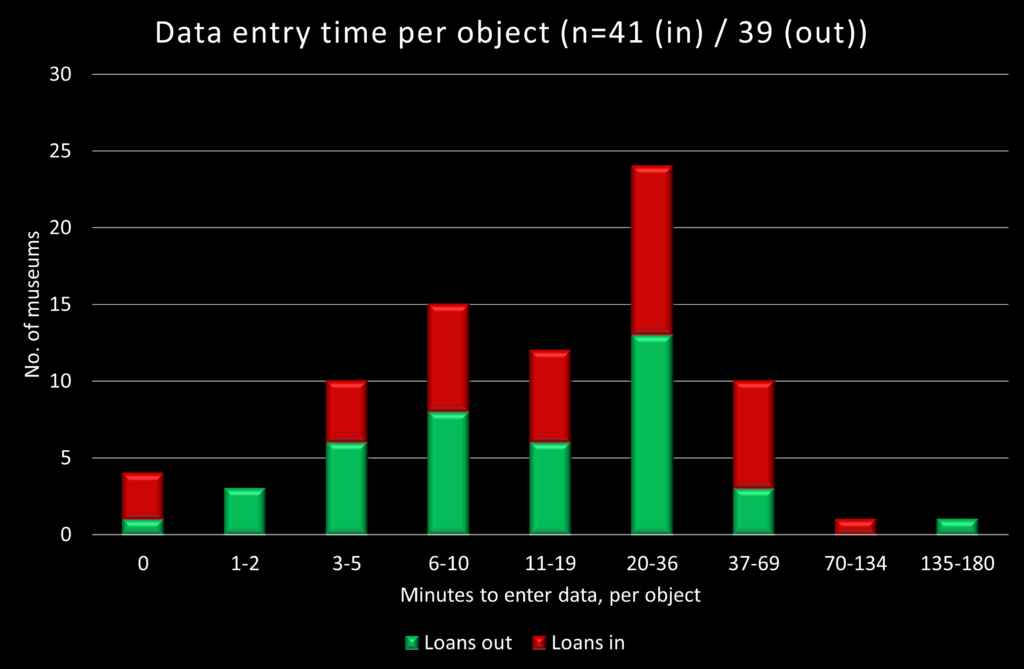
| Loans out | |
| minimum | 0 |
| median | 15 |
| mean | 22 |
| maximum | 180 |
| Loans in | |
| minimum | 0 |
| median | 17.5 |
| mean | 25 |
| maximum | 120 |
When it comes to the time spent on data-entry, the differences are reduced, with medians of 15 and 17.5 minutes per object for loans out and in, compared to means of 22 and 25 minutes for loans out and in. (We shouldn’t be surprised to find that loans out take less time, as lenders can often export the data from their collections management system directly into reports.) We do have two quite worrying maximums, of 3 hours per object for loans out, and 2 hours per object for loans in. But despite these two outlying values, the burden generally falls on the borrowing institution.
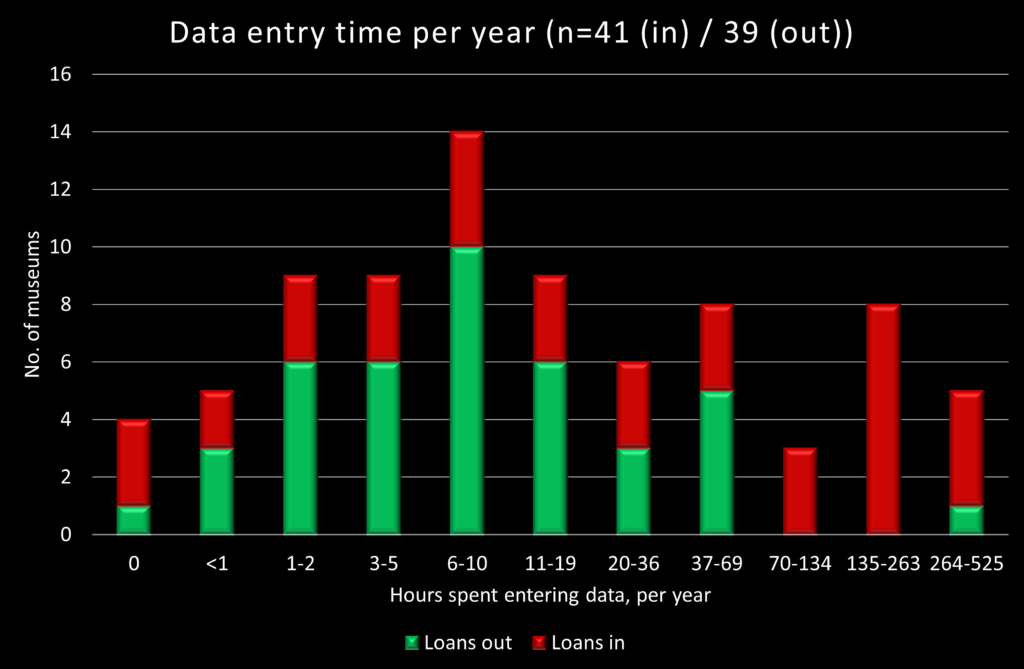
| Loans out | |
| minimum | 0.00 |
| median | 8.33 |
| mean | 23.28 |
| maximum | 375.00 |
| Loans in | |
| minimum | 0.00 |
| median | 33.33 |
| mean | 85.02 |
| maximum | 525.00 |
When we look at the time spent per year on loan–related data-entry, shown here in hours, then that difference become quite obvious: the median for loans out is 8 hours 20 minutes per year, for loans in it is 33 hours 20 minutes. Once again, a few institutions report much longer times, which gives us means of 23 hours 15 minutes per year for loans out, and 85 hours for loans in – and maximums of 375 hours for loans out and 525 for loans in.
The results become more striking if we focus on the figures for loans in, and convert them into days spent on data entry over a 10-year period. We assume that staff spend a full 7 hours a day on data-entry, this gives a median time spent on data entry for loans over a ten year period of 48 days, and a mean of 121 days – over half a working year. And in the case of one institution, loan-in data entry would take 750 days: nearly 3.5 working years. There are too many variables to convert these figures into salary costs, but there would seem to be a significant potential to make long-term savings if we can automate loan-related data entry.
Additional information
Respondents were also asked:
8. Is there anything else you think we should know about the answers you have given, or loan-related data-entry in general?
This section combines responses to that question, with explanations added to responses to other questions.
Loans out
- Up to 1 minute, the CMS outputs the data in the CMS into a loan agreement for us
- Outgoing loans managed through CMS
- As we have low IT skills and variable data we rarely do this
Loans in
- [Time is] per record (new object), many are renewals so data already exists and is updated
- We only record long-term loans in our collection man[agement] sys[tem]; short-term loans only in Excel object lists
- We don’t
- Currently the module for this isn’t developed on the CMS so this takes considerably longer, probably up to 1hr all told
- N/a – Incoming loans not managed through CMS
- As we have low IT skills and variable data we rarely do this
Generally
- We seldom need to borrow objects as we have a good collection for our needs. So we lend more objects then we borrow.
- It takes a lot of time to load the pages. The overall budget depends. It can be much higher, if the collection is in rotation for a blockbuster exhibition.
- Not included is time spent setting up organisational record and loan record which may involve setting up new authority records. Bespoke system means that there are some fields required by system which are not always relevant. Private lenders often aren’t able to provide required information so this has to wait until arrival adding to the time involved in data entry
- We write our own Oracle based software and it would be great for our loans to link to our CMS, but sadly no resources at the moment. We are a small part of a larger data based institution.
- We have built custom Crystal Reports to generate outgoing loan paperwork such a loan agreements, condition reports, and shipping receipts. This has minimized the time spent copying and pasting into other documents, though it hasn’t eliminated it. Not all staff has TMS access and many internal cross-departmental workflows employ Google Suite, so that is where most of the copying and pasting happens. Incoming loans require significantly more copying and pasting on the front end as we receive information piecemeal and in many different formats from curators, lenders, gallerists, etc.
- The answer is given for a group of five municipal museums
- Pertaining to question 2: we use crystal reports to attach object data to our agreements. So it doesn’t take nearly as much time as ‘copy and pasting’ data from objects on loan. It requires verifying the current data (which is done during/as part of the loan request approval process), building a group and running the report. Pertaining to question 3: The museum has 3 large managed loan collections which do require yearly work regarding records updates, updated agreements, etc. We also facilitate loans on behalf of those collections to other institutions.
- Questions often difficult to answer. With special exhibitions [there] are more external objects to work on, without exhibitions, of course, not. Several systems in use at the same time, no reconciliation between the systems, still a lot of manual work for loan contracts, permanent loan contracts, these are managed with Word and Excel.
- The poor legacy practice comes from a bespoke system being unfit for purpose – moving culture is proving a challenge. This assumes everyone thinks about working this way [i.e. entering data into collections management systems] – there will be a significant number that just don’t think like this. Who is allowed access to CMS or wants ‘control’ are important factors as well as how easy is it to do.
- Incoming loans: 45 to perm collection; 500 to temp exhibitions. LOTS of issues with information sharing around exhibitions.
- For larger loans the object schedule can be produced through a reporting program. Information is also copied for transport handlers; curators; conservators etc. For inward loans the records need creating on the database so this can often be more time consuming.
- We are in a process of procuring a new collections management system.
- As lenders we issue our loan agreements in a standard form (which draws the object info directly from the CMS record) so the 5 minutes is mainly checking and tidying up data. For incoming loans info is provided in a number of ways from various types of lenders, institutions, private lenders, artists etc. so it takes more time to enter into our CMS.